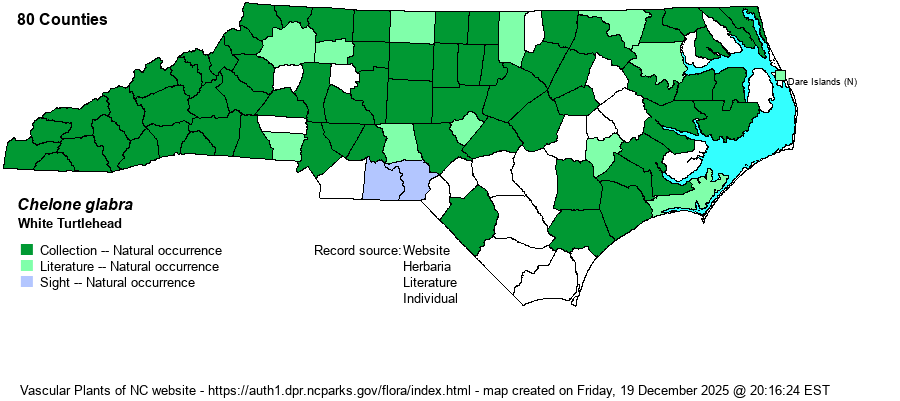| Author | L. | |
| Distribution | Throughout the Mountains, essentially throughout the Piedmont, and found over nearly all of the Coastal Plain, with considerable gaps in the Coastal Plain. Not widespread in the southern Piedmont and southern Coastal Plain.
This is a very widespread species of eastern North America. It ranges southward to central GA and MS.
| |
| Abundance | Frequent to common in the Mountains; fairly common to common in the northern and central Piedmont, but rare to uncommon in the southern counties. Uncommon to at least locally fairly common in the northern and central Coastal Plain, but rare in the southern counties (absent in the Sandhills). The NCNHP's S3S4 State Rank was coded several decades ago. With better and more recent information, the species is certainly of S5 State Rank, as it is known from roughly 3/4ths of all counties and may well occur in all of them. | |
| Habitat | This is a species of wet spots in shaded or partly shaded places, usually under a hardwood canopy. It occurs in openings in swamps and bottomlands, in wet thickets, around wooded pools, in seepages, and along boggy margins of stream banks. |
| Phenology | Blooms rather late in the summer and in fall, from August into October; fruits from September to November. | |
| Identification | This is a familiar and fairly often seen species, easily obvious when in bloom, but for much of the late spring and summer it remains in vegetative form, where it can be easily overlooked or left alone for identification purposes until an inflorescence is noted. It is mostly unbranched, with the stem reaching 2-2.5 feet tall on average, and numerous but scattered pairs of opposite leaves. Each leaf has a short petiole about 1/4-inch long, and mostly lanceolate leaves with numerous but shallow serrations. The leaves reach about 5 inches long but only about 1-inch wide, generally dark green in color. The top several inches of the stem consist of the dense spike of flowers, each shaped like a turtle head and about 1.2 inches long. Flowers are either all white, or often white with a rose colored tip. When viewed from above, the flowers are not arranged in 4-ranks, as is C. cuthbertii, so the flowers are not sitting directly over others. The other two species in the state -- C. lyonii and C. obliqua -- have rose-colored flowers throughout, but it may be tricky separating these three just by leaf characters. Because it blooms so late in the summer, it is typically more often encountered just in vegetative condition in late spring and summer. But, when seen in bloom, it is quite striking, as it usually grows in small clusters. | |
| Taxonomic Comments | Quite a few varieties have been named for this species, though Weakley (2024) does not consider them as valid.
| |
| Other Common Name(s) | Essentially none | |
| State Rank | S3S4 [S5] | |
| Global Rank | G5 | |
| State Status | | |
| US Status | | |
| USACE-agcp | OBL link |
| USACE-emp | OBL link |

